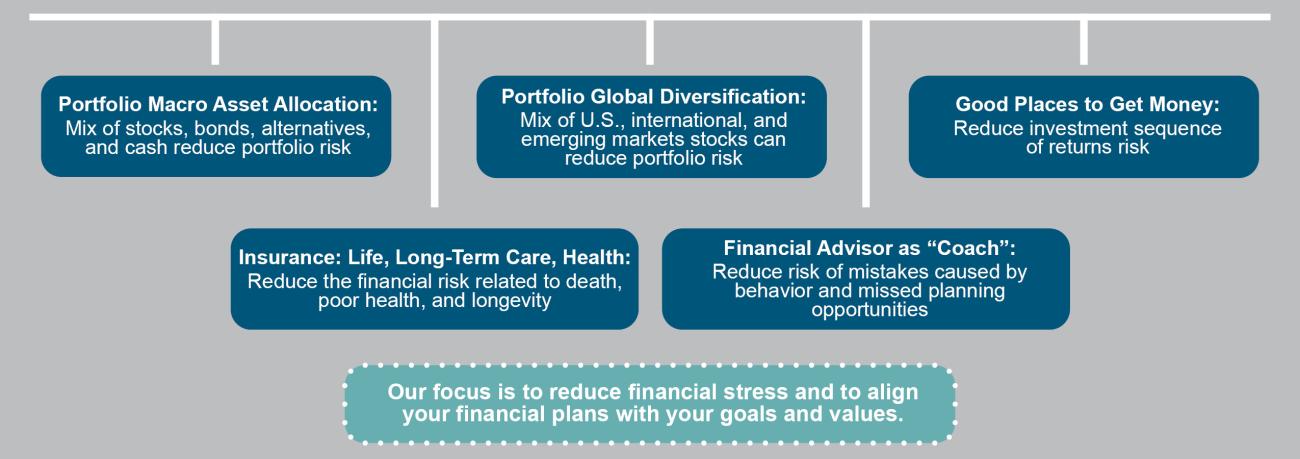
Elements of Risk in Financial Planning
By Marc Usem
”Luck and risk are siblings. They are both the reality that every outcome in life is guided by forces other than individual effort.” – Morgan Housel, The Psychology of Money
Like it or not, risk is a part of life. In order to eliminate risk, you would need to be able to control every possible factor affecting every possible outcome. A task we can all agree is unrealistic.
But, that doesn’t mean that we live entirely at risk’s mercy. Nor do we mindlessly follow a random trajectory through life. We make decisions every day that affect what type and how much risk we are exposed to. Risk is a particularly important factor in financial planning.
Types of Risk
Risk comes in many forms and from many different sources. When thinking of financial risks, you probably think of the unpredictable nature of stock market returns. But, there are also behavioral risks, such as buying due to the fear of missing out (FOMO) or selling due to panic. There are also physical risks, such as living longer or shorter than you had planned. Below are some of the types of risk that may be encountered as part of your financial planning process:
Three Dimensions of Risk
There are three primary dimensions to consider when determining the right amount of risk for your investment portfolio or financial plan: risk tolerance, risk capacity, and risk composure.
Risk tolerance is how much risk are you comfortable taking. Risk tolerance is an emotion-based dimension that attempts to gauge how much risk you can handle, while still being able to sleep soundly at night.
Risk capacity is how much risk you are able to reasonably take based on the risk of meeting or not meeting your goals. Risk capacity attempts to measure how much you can afford to lose, or would not need to gain, while still staying on track toward your overall financial goals.
Risk composure is your potential for dynamic feelings about risk based on a financial situation or condition. It is a behavior-based dimension that attempts to describe how you might behave differently if faced with a more significant financial event such as a large loss or outsized gain.
In order to accurately determine what type and how much risk to take on in your financial plan, we recommend considering all three dimensions of risk. Looking at just one, or even two, of the dimensions without the others may give an incomplete picture. For example, you may have a very high risk capacity, meaning you could take on a high degree of risk and still have a strong probability of reaching your financial goals. But, if your risk tolerance is low, and the thought of even small financial losses keeps you up at night, a financial plan with significant risk would not be the right fit for you.
Risk and Control
Risk is an inevitable part of life. But that doesn’t mean that you have no control over it. In fact, some types of risk are entirely in your control. It is important to be aware and take advantage of the risks you can control, such as financial planning, portfolio diversification, and your investment strategy. Even risks you can somewhat control, such as health and behavior, and risks you can’t control, such as market losses or longevity, can benefit from solid financial planning.
How We Can Help Reduce Risk
At Affiance Financial, our advisors guide you through the various risk factors that can affect your financial plan. They help ensure that your financial plan contains the right amount of risk for your risk tolerance, risk capacity, and risk composure. They help ensure that you have taken steps to address those risks that are within your control, and that you have a plan to address the risks you can’t control. This includes designing globally diversified portfolios with a mix of stocks, bonds, alternatives, and cash. It may also encompass ensuring you have a good place to access cash during a market downturn, guiding the creation of an insurance portfolio that suits your specific needs, and acting as a “coach” to help you avoid behavioral risks.
Risk is the reality that every outcome in life is guided, in some measure, by forces other than individual effort. Accepting risk, understanding risk, and managing risk, helps us create financial plans that can best meet your financial goals. If you’d like a professional review of your financial plan’s risk profile, please reach out to your advisor today.
All investment strategies have the potential for profit or loss. Asset allocation and diversification do not ensure or guarantee better performance and cannot eliminate the risk of investment losses. Affiance Financial only conducts business in states where it is properly registered or is excluded from registration requirements. Registration is not an endorsement of the firm by securities regulators and does not mean the adviser has achieved a specific level of skill or ability.





